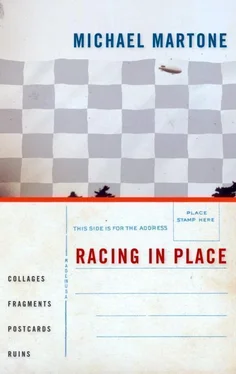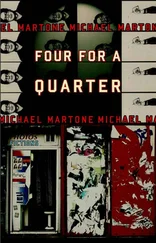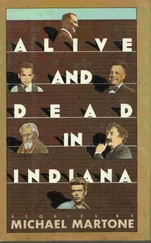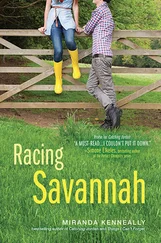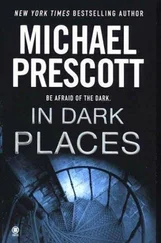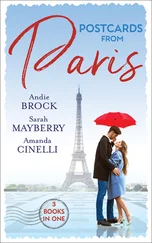An Essay on Astronomy
One can watch the moon rise above this moon. And people do, parked in the empty Moon Winx Lodge parking lot, arrayed in a drive-in movie semicircle of cars, the pattern shadowing the crescent of the crescent moon floating a few feet above them. People come to just watch this moonlight of the moon sign. This moon lights up at dusk, begins to wink, the stuttering spark, the rippled strobing of the inert gases in the tubes. The road runs east and west here, a transcribed latitude the Moon Winx moon intersects and the real moon traces in its courses. If one's lucky the other moon rises above the pines in the distance and then the buildings next door. The moon rises over the shoulder of, balances on the edge of, the blinking simulacrum of the moon. The sign becomes a kind of instrument-a sextant, an astrolabe, or the simple arc of a protractor and plumb line. One closes one eye and takes aim at the phenomena of this asphalted heaven. One shoots the moon as it moves through the night above Tuscaloosa. The moon is in transit across the moon. The sign's single eye eyes the moon's track, tracking the moon. Its cratered eye peeled and rolling up into its blinking lid. The moons are eye to eye. And the two o's of the "Moon" seem to ogle the rising moon. The real moon turns white like some kind of fluorescent bulb itself. "Oh!" the o says and "Oh!" again the other o echoes. This is glacial fireworks. One "oohs" and "ahs" as the moon inserts itself above the moon. Oh, strange cell division! Then, one can do it all again. Orbit the sign and set up station on its far side. There, watch the moon set below the arching outline of the moon, watch the lozenge of the moon slip behind the moon, swallowed then by the open mouth of the moon, a moon within the moon.
An Essay on the Neighborhood of Neon
The Moon Winx Lodge is in a neighborhood of neon on the east side of Tuscaloosa. The "Flora Signs" sign, exfoliating ever expanding petals of neon filigree, tops the hill above the Moon Winx. I imagine that company has something to do with this precinct of light twinkling along the street. The Bel Aire Motel's sign, a sapphire waterfall, is within sight of the Moon Winx. A block or two farther west, leading farther into Tuscaloosa, is Leland Center, whose asymmetrical cacophony of neonencrusted signage disappeared in a recent beautification effort of the Alberta City suburb. The light sparked and flashed but the sign itself, the underlying skeleton, cantilevered and jointed, was framed with contrasting shapes, organic and industrial. Nearby a Mason's lodge in a loft is identified with a second story-hanging pendant of neon, the proprietary compass of the order outlined in pulsing green. A tattoo parlor is tattooed with a blood red statement, "Tattoo," rendered in a corduroy effect of letter within letter, a vibration, tiered in a way that recedes inward or, if you look at it the other way, back outwards. And off in the distance on the other side of the parking lot is the Leland Bowling Lanes, faced with its three-story wobbling pin and planet-sized bowling ball, pockmarked with finger holes and outfitted with rings of neon in concentric circles, a target, that, at night, lights up the illusion of depth and distance as the ball rolls away in ever-shrinking halos until, suddenly, it reappears, massive black and back, the big bang, at the starting point, a warp of time, a crazed loop looping. A new arrival is a Sonic drive-in, one of the chain of identical boxes, the building and awnings clad in endless wirings of light, an architectural "quotation" quoting the past that is still present all around it here. It sits there, self-consciously, I think. It is all neon and all about neon. Neon for neon's sake. Its tubes are not bent to animate or to make a gesture toward the gestures of objects we are meant to desire. Nothing appears or disappears, the old urban hypnosis. Not that. The Sonic is transparently illuminated. Sometimes the tubes of light are just tubes of light.
An Essay on Film
Students set up their cameras in the parking lot of the Moon Winx Lodge. Scenes have been written to be staged beneath the sign. Actors act, play out their domestic dramas with the goofy sign walleyed in the middle distance. Or at night, the sign provides the only available light, exposes the shadows with its backlighting. The sound of its humming neon, a kind of snoring, has been collected on endless spools of magnetic tape or nowbottomless bits of digital memory. The metronome of its switching valences keeps time, ambient meter pulses beneath the pingpong dialogue of the backlit principles. I like the sign best when it is out of focus, smeared illegible in the background until it is pulled into view, etched in the inky night, a dissolve that resolves the scene, an establishing shot that materializes out of the soft cloud of hovering light. The moviemakers are attracted to the Moon Winx like the moths who can't help themselves. The cameras roll, recording this epic-insect invaders of the moon. It is all so damned atmospheric, this moon. So suggestive. A moody moon. The film crews hose down the empty blacktop, hoping to capture the moon's eel-like reflection in the shimmering pools, the pools already steaming in the hot southern night.
An Essay on Lunatics
She is one of many who walk the streets of Tuscaloosa. They are mainstreamed now from the city's half-dozen asylums. The old railroad tracks curve along the fence line of Bryce Hospital, past the front gate, and then cut through the university next door. A joke often repeated is that a passenger getting off here would be hard pressed to tell the difference between the two state institutions. She follows the old rights of way, her marching cadence matching the verses she shouts. A flock of spondees circles her. She walks each day from one side of the city to the other. As I pass her in the car or as I am walking by, I hear snatches of her ambulatory sermon-a patchwork of damnations, rhetorical questions, ecstatic description, gothic tableaus. Other patients are roped together, mountaineering the arching viaduct, spelunking the underpasses. A city animated by cadres of distracted constitutionals. Old men wander Fifteenth Street, bindle stiffed and muttering, giving directions to themselves and each other while even older men wobble on ancient bicycles, collect crushed cans from the gutters, filling saddle bags made from plastic store sacks. I saw her as I was driving down University. There she was, stopped in her tracks, gesticulating, staring at the smiling moon of the Moon Winx Lodge, silent for once. I watched her in the rear view mirror reversed. The writing on the sign all backwards, her face turned up, trying to think of what to say to that beneficent expression looking down at her.
A Note on Blackbirds as Notes
A blackbird sits on the topmost tip of the crescent moon. Another blackbird perches on the curving point below the bemused cartoon profile of the man in the moon, a bas-relief rookery. A passing horn startles both from their roosts. They become airborne punctuation: a semicolon. For a moment, they form that formation, exponent suspended, the final stroke: a bass clef.
An Essay on Dreams
I like the new evolutionary theory of dreams, of why we dream. An animal more likely to survive is one who can stay still, and sleep keeps one still. Dreams evolved, so the theory goes, to keep the mind busy while the body sleeps. Dreams take the mind's mind off waking, make the mind mind. This sign is a dream itself, a dream of itself-with its flying buttress of articulation, its squareless expressionism askewing every angle, askance glance. In the dark, its various shapes unhinge and float, solid matte slabs behind the wired light, a mobile of rhomboid shadows, polyhedral swatches, interrupted radii. The sign is a dream. The sign is a sign signifying "dream."
Читать дальше
